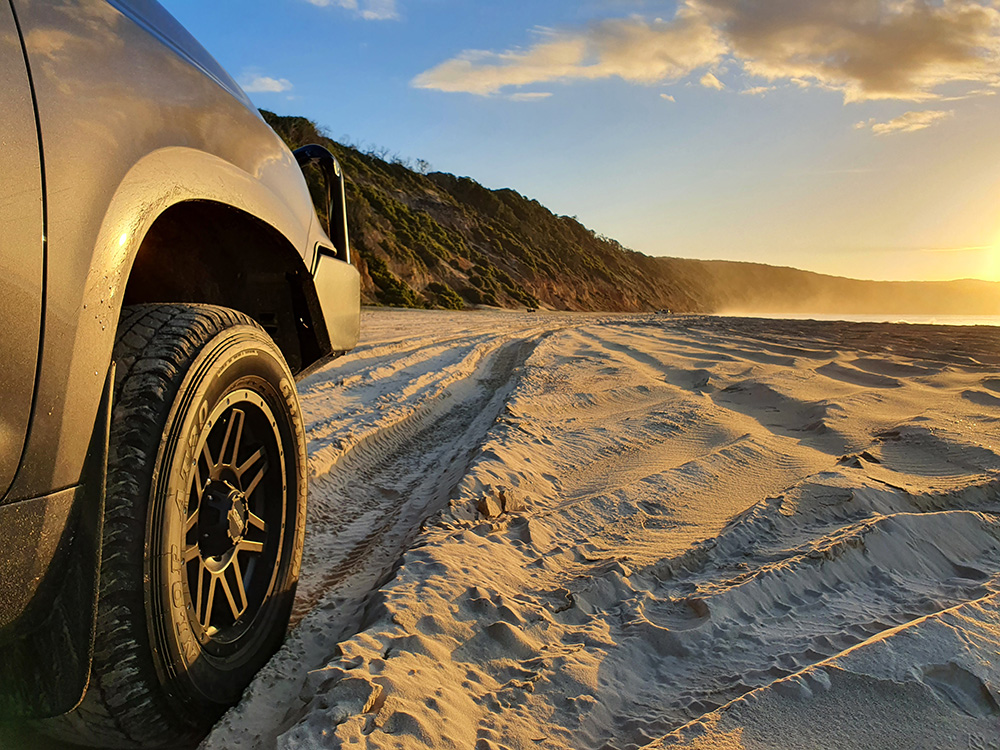Deciding on the best all terrain tyres for your 4x4 is a difficult task. On bitumen roads you want a soft, quiet ride, good cornering and stopping ability in both wet or dry weather conditions. You also want good tracking to avoid driving fatigue for highway driving and good balance to avoid any vibration. Tyres with a low rolling resistance will also give better fuel economy and since we do pretty big kilometres on some trips a small difference here could add up to hundreds of dollars. But off-road the requirements are very different again. You want an open tread for good self-cleaning properties in mud, you want resistance to punctures with a heavy duty construction and plenty of all-round grip. In all cases you want your tyres to be as low cost as possible and to last as long as possible before needing replacement.
Obviously some of these requirements are contradictory. Big open treads that are great in the mud tend to be noisy on the bitumen. Hard compounds that last a long time tend to have worse wet weather cornering and stopping ability. The "light truck" or LT construction tyres have superior load carrying performance and puncture resistance however they are also heavier, can use more fuel, can have a harder ride, and often cost a lot more. Basically good on-road tyres tend to be poor performers off road and vice versa.
You may have noticed how dogmatic some people get about their favourite tyre brand or type. That's fine of course but in the real world we all have different needs and have to weigh up all the different aspects to find the right choice for our case.
Finding information and comparisons is also a very difficult task. Every manufacturer claims their tyre is quiet, tough, and has the best grip in all conditions. Are they really all the same? It is always disappointing when a magazine or website claims to have a "mega" tyre comparison and then just quotes all the brochure data that doesn't prove anything. Every now and then someone will actually do driving tests with a range of different tyres but chances are they won't have all of them, or at least the one you were considering, right? Review sites are also an interesting source of information. These are pretty good, except that for every tyre you will find some people saying they are the best, and some people saying they are the worst tyre ever made. It is hard to know what to believe.
Popular 4WD Tyres
There is a seemingly endless choice of tyre options to choose from but here is a list of some of my favourites.
| Tyre | Comments |
|---|---|
| Bridgestone Dueler A/T D697 | A great reputation as a tough, reliable tyre with excellent off-road performance. Some say it can get noisy and less grippy over time. |
| BF Goodrich KO2 | Very popular for serious off-roaders. Exceptionally tough and reliable tyre. Possibly a little noisier than some tyres and age may reduce grippyness. Also pretty expensive. |
| TOYO Open Country AT2 | A surprisingly smooth, quiet ride on-road with serious off-road design and ability. This tyre has a great reputation. |
| Pirelli Scorpion ATR | A well known great all rounder with a good history of great on road performance with reliable if basic off-road ability. |
| Pirelli Scorpion All Terrain Plus | A relatively new option that improves on the success of their old ATR. Even better off-road performance with bigger, more open tread pattern, but also retaining good on-road characteristics. |
| Michelin LTX Force | Not well known but a tyre with great reviews for being smooth, quiet, grippy in all conditions, with reasonable off-road performance. |
| Dunlop Grandtrek AT20 | These are the original tyres fitted to the current Toyota Prado. They are a reasonably good all-round tyre, mainly suited to highway use, very low noise, smooth, good fuel economy. Ok in sand and gravel but fairly easy to damage sidewalls so have to be super careful off-road. |
Tyre Rotation
To get the most out of a set of tyres they need to be rotated every 5000km or so. If you don't they will wear unevenly. In some cases they can develop wear patterns that result in them becoming very noisy. They could just start humming or could get to a point where you might think you have a blown diff or worn wheel bearings. To rotate your tyres move the rear tyres straight to the front keeping them on the same sides they were on. Move the front tyres to the rear but swap sides so that they are actually rotating in the opposite direction. In a full cycle of rotation this will mean that every corner of every tread block will get the same wear and this will hopefully reduce uneven wear that causes excessive noise.
It is very important to note that if you ever put tyres on the front that are running in the opposite direction that they were previously, you can create an effect where the steering feels very touchy. It will feel like you have to constantly correct the direction of the vehicle, that every bump and groove in the road causes the steering to vear. Sometimes this is referred to as "tramlining", where the car wants to follow grooves in the road instead of staying straight. This is caused by the wear in the tread going in the opposite direction. The solution is to only put tyres on the front that have been going in the same direction for at least a few thousand kilometres.
